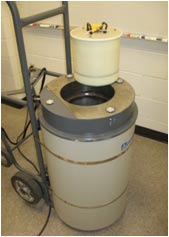
AWCC Detector at ORNL
A technique that detects prompt neutrons from spontaneous or
induced fission in a sample and distinguishes them from neutrons
from other sources (such as α,n) reactions) by separating detected
events that occur closely together in time (correlated events) from
those that are randomly distributed in time. The correlated events
are counted to produce a measurement result indicative of the
amount of fissionable isotopes in the sample.
The high level neutron coincidence counter (HLNCC) has been
designed to handle high count rates and therefore large samples of
Pu.
The active well coincidence counter (AWCC) incorporates an
isotopic source (e.g. AmLi) that randomly produces neutrons used to
interrogate a fissionable sample. The prompt neutrons from the
induced fission are then detected to verify large samples of U. The
sensitivity of this active non-destructive assay device is higher
than that of the passive HLNCC.
Various instruments have been developed which incorporate this
technology and are adapted for the verification of specific nuclear
material items, such as light water reactor fuel assemblies or fast
reactor fuel elements.